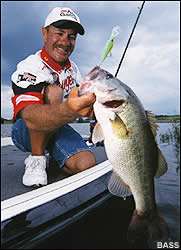
It doesn’t surprise T.J. Stallings that so many anglers sing the praises of Daiichi’s Bleeding Bait Hooks. As a tad, Stallings helped out in his father’s bait shop, Tim’s Tackle Box, located near Orlando, Fla. One of his responsibilities was a dog and pony show designed to increase sales.
“I would lower different-colored crappie jigs into the minnow tank,” says Stallings. “The minnows would chew on the red jig and ignore every other color. Red wasn’t popular, but we could get most folks to buy one. They’d come back later and snap up a bunch more because that red jig caught more crappie than every other color they fished.”
These days, Stallings heads sales and marketing for Daiichi, a company that offers red Bleeding Bait Hooks in trebles and in various designs for soft plastic baits. Though Stallings freely admits Daiichi was not the first to introduce red hooks, he takes credit for enlightening anglers to the benefits of the bright barbs.
“Bleeding Bait Hooks have a highly visible, reflective red color,” says Stallings. “Bass probably see it as blood or gill flash. Either way, there’s no doubt red hooks trigger more strikes.”
You won’t get any arguments from Tennessee fishing guide Jim Duckworth, who has practically lived on Old Hickory, Center Hill, Dale Hollow and the Cumberland River for two decades. Over the past 10 seasons, he has averaged more than 300 days annually on the water.
As a member of the Daiichi Pro Staff, Duckworth began experimenting with prototype Bleeding Bait Hooks three years ago. The most convincing of his ongoing experiments is to replace only the front treble on a crankbait, jerkbait or topwater plug with a Bleeding Bait Hook.
“When you fish with customers almost every day, you can do some serious testing,” says Duckworth. “Whoever casts a bait with a Bleeding Bait treble catches about 95 percent of his fish on the front hook. With baits that don’t have a red hook, 95 percent of the fish are hooked on the rear treble.”
Wouldn’t two red trebles draw more strikes than one? Possibly, but Duckworth prefers to go with one treble because the strike-to-catch ratio increases significantly when bass are impaled by the leading hook.
“When I take guys out to practice for a tournament, we fish baits that have red trebles on the back,” says Duckworth. “Almost all the bass nab the rear hook, which makes them easier to shake off.”
Duckworth claims Bleeding Bait Offset Wide Gap, Dropshot and Copperhead hooks also draw more strikes when he and his clients fish soft plastic baits.
Arkansas CITGO Bassmaster Tour standout Scott Rook echoes Duckworth’s findings, especially when it comes to treble hooks on hard baits. Over the past year, he has replaced the front trebles on his Frenzy crankbaits with Bleeding Bait Hooks. The results have been so overwhelming that he now refuses to fish a crankbait without a red hook.
“It’s amazing,” says Rook. “Almost every single bass I catch has that red hook in its mouth. I hardly lose any fish with them.”
Rook claims the red hook advantage diminishes when he fishes crankbaits that run deeper than 12 feet. He believes the red hue is not as visible to bass in the murky depths.
The same holds true with soft plastic baits, according to Alabama’s Rusty Faulk, who hosts the Rusty Faulk Fishing Show on the Outdoor Channel.
“The Bleeding Bait Hook works great on Texas rigs,” says Faulk. “But in my experiments with it over the past year, I find it works best with floating worms and soft stickbaits. They dance and dart above the bass where the fish can better see that red flash.”
Bleeding trailer hooks
When he fishes a soft jerkbait, such as a Twitch Assassin’, Duckworth opts for a Bleeding Bait Copperhead hook. Before he threads the bait onto the hook, he slips a No. 2 Bleeding Bait treble over the barb of the Copperhead. The treble adds red flash and misses few bass. Stay away from heavy cover with this rig.
Duckworth also has had exceptional results using Bleeding Bait single and treble hooks as trailer hooks for spinnerbaits and buzzbaits. He fixes the trailer hooks in place by slipping short pieces of aquarium tubing over the hook eye. Aquarium tubing is easier to come by than surgical tubing.
(Contact: Daiichi, 800-421-5768; www.daiichihooks. com)





